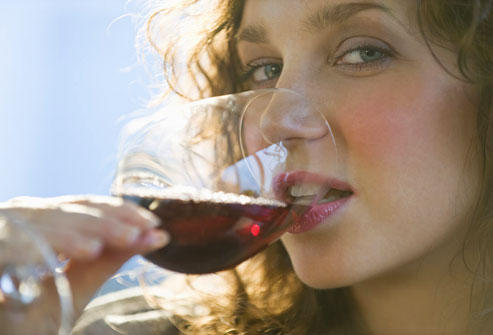Do you feel embarrassed when your cheeks resemble Santa's soon after you finish your drink? You are not alone. Many people have this problem and wonder exactly why their faces turn pink when they drink alcohol. Does this happen whenever you drink? Is this because you have hypertension? Is it due to alcoholism? Come find out the answer.
Why does My Face Get Red When I Drink?

If you flush after drinking, you may have a condition called Alcohol Flush Reaction (AFR). This usually happens when you have a genetic deficiency that leads to an enzyme disorder in the liver. This makes it difficult for your body to break down the oxidized version of alcohol called acetaldehyde.
Under normal circumstances, your body is capable of converting acetaldehyde into acetate without a problem. However, the process is carried out with the help of an enzyme called ALDH2, and in the absence of this enzyme, your body just cannot complete the process. When there is an excess of acetaldehyde in your body, this dilates your blood vessels and turns your skin red.
Symptoms of Alcohol Flush Reaction
Why does my face get red when I drink? You already know the answer, but you might be wondering how to tell if you have alcohol flush reaction.
The most common symptoms include headaches, nausea, heightened heart rate, and of course, flushing of the neck and body. Some people develop these symptoms as soon as they finish their first drink. Also, bear in mind that most people think that AFR is limited to Asian people, and that is why it is also called "Asian flush", but the reality is that it can happen to anyone, over 500 million people around the world suffer from this condition.
Is It Serious?
Just like any condition, AFR may have certain negative effects on your health. Studies show that you are at an increased risk of developing esophageal cancer if you have alcohol flush reaction and continue to drink alcohol. However, many studies have also found that there aren't many alcoholics in countries where there are more people with the genetic variation. In other words, the negative side effects keep them from drinking regularly.
Some studies have found that there may be a link between alcohol-related hypertension and people with AFR. What causes it is not clear but this may have something to do with excess acetaldehyde in the blood. It dilates your blood vessels and may limit the blood flow to the central organs. This compels your body to secrete hormones to increase blood flow to the central organs, and this in turn leads to an increase in blood pressure. It is therefore a good idea to limit your alcohol intake if you have AFR to prevent hypertension.
Is There a Cure for This?
 You can try a number of ways to manage flush, but there is no specific cure. Knowing the answer to "Why does my face get red when I drink?" really helps you to make lifestyle changes, but you can try some other ways as well. For instance, you can try green-tinted concealer to neutralize the effect of flush. You can also opt for laser treatments to minimize the appearance of blood vessels near the surface of your skin. It is important to avoid using harsh Microdermabrasion, exfoliates, and products like retinol.
You can try a number of ways to manage flush, but there is no specific cure. Knowing the answer to "Why does my face get red when I drink?" really helps you to make lifestyle changes, but you can try some other ways as well. For instance, you can try green-tinted concealer to neutralize the effect of flush. You can also opt for laser treatments to minimize the appearance of blood vessels near the surface of your skin. It is important to avoid using harsh Microdermabrasion, exfoliates, and products like retinol.
Here are some other ways to minimize the overall effect of flush:
1. Limit Your Alcohol Intake
The simplest way to keep things under control is to limit your alcohol intake. Men should not have more than a couple of standard alcohol drinks per day and women should limit them to one drink a day. One alcoholic drink means a glass of wine or a can of beer.
2. Do Not Binge Drink
Binge drinking affects your body's ability to break down compounds in alcohol. It is important that you do not take another drink until the redness produced by the first drink subsides. This will help prevent acetaldehyde overload. Keep in mind that your liver is a powerful organ but it can only metabolize 30ml of alcohol an hour.
3. Go for Drinks with Low Alcohol Content
Be sure to know the alcohol content of what you drink. Check the bottle labels and opt for drinks with the lowest alcohol content. White or red wines with no more than 12.5% of alcohol per volume will do. Going for wine coolers, beers, and table wine is a better option than spirits.
4. Eat Something While Drinking
It is a good idea to eat something before you start drinking. You should also keep eating something whilst drinking to protect your stomach lining from excessive irritation caused by alcohol. Snacking on carb-rich and fatty foods such as nuts, seeds, pasta, pizza, and bread may help slow down the absorption of alcohol in the body.
5. Keep Hydrated
Always bear in mind that you should drink plenty of water after drinking alcohol because alcohol is a diuretic. It makes you thirsty, but you should quench your thirst with non-alcoholic drinks only.
